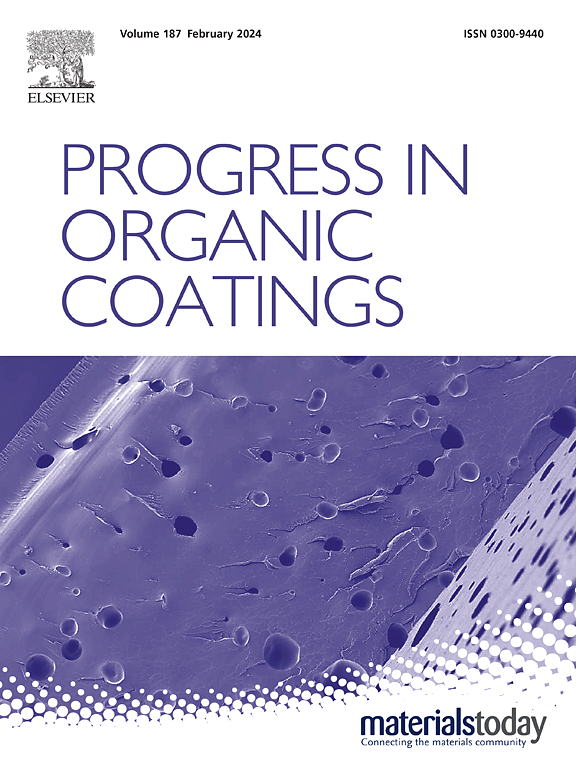基于苯酚-氨基甲酸酯键合的水性聚氨酯:自我修复,形状记忆,防污和抑菌功能
IF 7.3
2区 材料科学
Q1 CHEMISTRY, APPLIED
引用次数: 0
摘要
为了开发一种多功能、高性能、延长耐久性和降低维护成本的材料,满足现代工业和环境应用的多样化需求,本研究制备了一种新型多功能水性聚氨酯(WPU)材料。通过将生物基化合物没食子酸(GA)掺入WPU基质中,形成了动态的酚-氨基甲酸酯键,赋予了良好的自修复能力,愈合效率高达92%。此外,铜基金属有机框架(Cu-MOF)的加入赋予该材料显著的抗菌性能,有效抑制大肠杆菌和金黄色葡萄球菌,使其适用于医疗器械和食品包装的应用。此外,聚二甲基硅氧烷(PDMS)的集成显著增强了材料的表面疏水性,实现了108°的接触角,从而提供了出色的防污性能。所得材料表现出优异的机械性能和热稳定性,而动态键的可逆性和多功能组件的协同效应增强了其智能和耐用性。这项研究为多功能wpu的设计和应用提供了一种新的方法,在柔性电子、智能涂料和抗菌防污技术方面具有潜在的用途。本文章由计算机程序翻译,如有差异,请以英文原文为准。

Waterborne polyurethanes based on phenol-carbamate bonding: self-healing, shape memory, antifouling and bacteriostatic functions
To develop a multifunctional, high-performance material with extended durability and reduced maintenance costs, meeting the diverse demands of modern industrial and environmental applications, this study prepared a novel multifunctional waterborne polyurethane (WPU) material. By incorporating the bio-based compound gallic acid (GA) into the WPU matrix, dynamic phenolic-carbamate bonds were formed, imparting excellent self-healing capabilities with a healing efficiency of up to 92 %. Additionally, the inclusion of a copper-based metal-organic framework (Cu-MOF) endowed the material with remarkable antibacterial properties, effectively inhibiting Escherichia coli and Staphylococcus aureus, making it suitable for applications in medical devices and food packaging. Furthermore, the integration of polydimethylsiloxane (PDMS) significantly enhanced the material's surface hydrophobicity, achieving a contact angle of 108°, thereby providing excellent antifouling performance. The resulting material demonstrated outstanding mechanical properties and thermal stability, while the reversibility of the dynamic bonds and the synergistic effects of the multifunctional components enhanced its intelligence and durability. This study offers a novel approach to the design and application of multifunctional WPUs, with potential uses in flexible electronics, smart coatings, and antibacterial antifouling technologies.
求助全文
通过发布文献求助,成功后即可免费获取论文全文。
去求助
来源期刊

Progress in Organic Coatings
工程技术-材料科学:膜
CiteScore
11.40
自引率
15.20%
发文量
577
审稿时长
48 days
期刊介绍:
The aim of this international journal is to analyse and publicise the progress and current state of knowledge in the field of organic coatings and related materials. The Editors and the Editorial Board members will solicit both review and research papers from academic and industrial scientists who are actively engaged in research and development or, in the case of review papers, have extensive experience in the subject to be reviewed. Unsolicited manuscripts will be accepted if they meet the journal''s requirements. The journal publishes papers dealing with such subjects as:
• Chemical, physical and technological properties of organic coatings and related materials
• Problems and methods of preparation, manufacture and application of these materials
• Performance, testing and analysis.
 求助内容:
求助内容: 应助结果提醒方式:
应助结果提醒方式:


